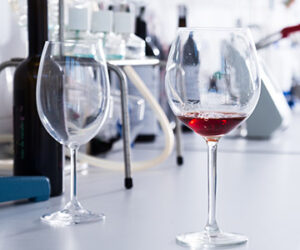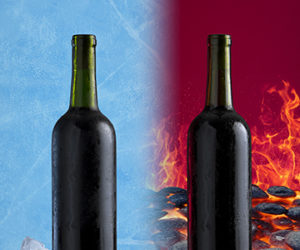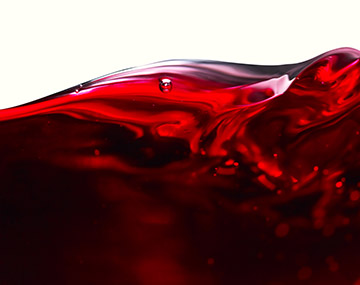
It is in red wine production that the impact of phenolics is most influential in determining wine style and quality. We know that what is happening in wine on a chemical basis will influence choices regarding processing options and timing of activities for different wine styles. In this article, we’ll explore how polyphenolics are extracted into red wine and how some processing options impact this extraction.
Phenolic Extraction as a Function of Molecular Size & Grape Berry Physiology
Molecular size and the location of the phenolic compound have a big impact on when and how much of a particular type of phenolic compound is extracted into wine. Anthocyanins, the phenolic compounds that contribute color to wines, are found predominantly in the skins in most grape varieties (there are a few grape varieties, called “teinturier” varieties, that also have anthocyanins in the pulp). Tannin compounds, the other really important group of phenolic compounds in red wine, are found in the skins, seeds, and pulp of grapes.
Color and tannin molecules found in the skin may be relatively easily extracted into the juice when grapes are destemmed and crushed, as the skin cells are disrupted during this process. These molecules are held in a matrix of skin cell wall structural material that includes pectin. Pectin is an amorphous polysaccharide that acts as a sort of glue, holding the fruit cells together. Therefore pectinase enzymes added just after crushing can help extract color and tannin from the skin. We’ll talk more about additives for manipulating color and tannin in a future article on phenolics.
The rate of extraction of color and tannin molecules from the solid matrix of the skin tissue into the liquid matrix of the juice is mostly determined by the size of the molecule. Anthocyanin molecules are usually only attached to one or two glucose molecules (called glycosylated), so the relatively small size of these molecules means they are extracted into juice quickly. Tannin molecules are most often incorporated into polymer forms. In skin tannin the average polymer size range is 3 to 83 sub-units in length.1 These much larger molecules are extracted more slowly into the juice.
An incredible amount of tannin is also available in the seeds of grapes, but these tannin molecules are bound more tightly in the solid structure of the seed, and some researchers believe the seed coat may also play a role in inhibiting the extraction of tannin from seeds during the early part of maceration and fermentation. However, once the seed coat has been loosened due to prolonged exposure to the juice, seed tannin extraction occurs more rapidly and becomes an increasing percentage of the overall tannin extraction into the young wine. Seed tannin polymer is composed of smaller tannin units, with a polymer size range of 2 to 16 sub-units.1
There is also some tannin in the pulp of the berry, but this tannin appears to have such a strong affinity for grape pulp cell wall material that very little is extracted into wine.2
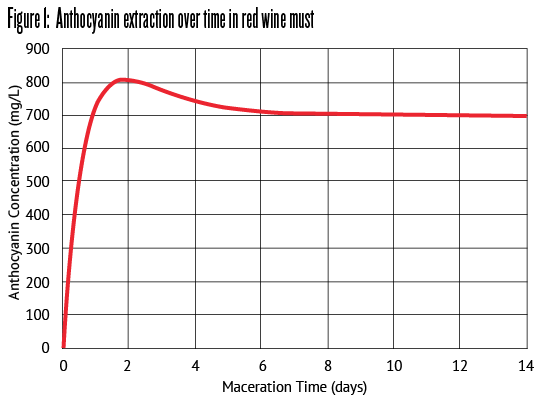
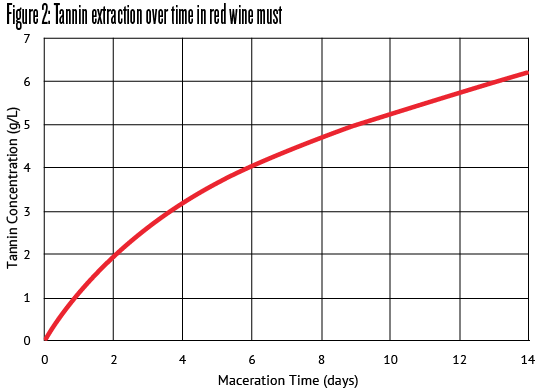
Small phenolic polymers are more likely to be perceived as bitter, while larger polymers are more often perceived as astringent (drying, or rough sensation). Some winemakers argue that because seed tannin is smaller and therefore perceived as bitter, that seed tannin extraction should be minimized. This may be true in instances where grapes contain excessive amounts of tannin, or the seeds are unripe, but in most wines seed tannin plays an important role in the overall tannin profile.3 A little goes a long way, however, and most winemakers believe seeds should be treated gently and never crushed in rollers that are too tight, or ground in pump internals or other processing equipment.
The size range of molecules, and their location in the berry, lead to different extraction rates for color vs. tannin during red wine fermentation. Color is extracted quickly during the beginning of maceration, then falls slightly toward the end of fermentation as some color molecules are oxidized or bound to other solids like yeast and potassium bitartrate.4 In contrast to color, tannin concentration increases gradually during the course of primary fermentation, with mostly skin tannin in the beginning and increasing quantities of both skin and seed tannin as contact time and temperature increases. Eventually the tannin extraction will level off, but will keep increasing slowly until the skins and seeds are removed from the new wine.
Examples of the extraction dynamics for color and tannin are shown in Figure 1 and Figure 2. It’s important to note that these figures are examples of the color and tannin extraction rates in wine production. These rates, and overall quantity of color and tannin extracted, can be quite variable depending on the grape variety, the growing conditions in a given year, the type and quantity of maceration process, and the maceration temperature. Vineyard activities for improving berry color go beyond the scope of this article (sunlight plays a big role). In the following paragraphs we’ll explore some common wine processing options and their potential impact on color and tannin.
Maceration Temperature
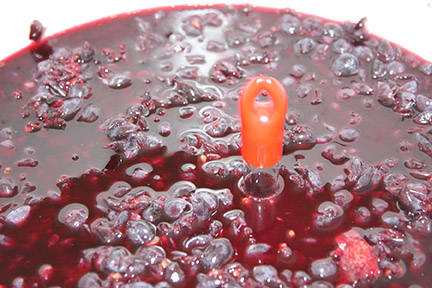
Maceration temperature was mentioned in the white winemaking phenolic article I wrote for the June-July 2020 issue of WineMaker as a lever to limit extraction of phenolic compounds by maintaining a low temperature during crushing and pressing. Using the opposite approach for red wine production, increasing the temperature can lead to a dramatic increase in the extraction of color and tannin. Research has shown that a 36 °F (20 °C) increase in fermentation temperature led to an 80–90% increase in tannin concentration.4 While this is a large temperature change (equivalent of going from room temperature of 70 to 106 °F (21 to 41 °C), even moderate increases in temperature during fermentation and maceration can have a beneficial impact for increasing tannin extraction. Many commercial winemakers like to see maximum fermentation temperatures in the 85–95 °F (29–35 °C) range in order to achieve high levels of tannin extraction. These high temperatures may be difficult for home winemakers to achieve, given the relatively small volumes and cool temperatures during harvest. However, with small-scale glycol temperature control units more readily available nowadays, one could be used to maintain the higher temperatures. Using insulated fermentation vessels may help retain the heat generated during fermentation, and tank electric heaters or using heat exchange coils circulating hot water might be other options to explore. Ethanol has been shown to increase tannin extraction as well, thus tannin extraction should accelerate during mid-fermentation (also usually accompanied by an increase in temperature). However, addition of ethanol is not a common winemaking process for most wine styles, so temperature remains the main tool that winemakers may adjust to increase tannin extraction.
There has been some interesting research recently on the interaction of anthocyanin and tannin molecules, and scientists are trying to determine whether increased anthocyanin levels generate an increase in the extraction and/or final concentration of tannin, or the quality of astringency perception, in the finished wine. I haven’t seen a definitive research analysis of this interaction yet, but there are winemakers who believe that in order to make high-quality wines with velvety tannin profiles, it is necessary to also have a high concentration of anthocyanins.
Maceration Options
Cold Soak
There is conflicting research data on whether cold soaking is beneficial in terms of color extraction. Some research has shown a moderate increase in color extraction using cold soaking,5 other research has shown no difference in color, or even a slight color loss, between cold soaking and a standard maceration schedule. Similar research has shown a slight decrease in tannin extraction when a cold soak is utilized, but this technique remains quite popular in some regions and with some grapes, so it begs the question if more research may be needed on this technique. Besides the possible impact on color, some winemakers also like cold soaking because they believe the added time before active Saccharomyces fermentation may give other microbes a chance to increase the aroma complexity of the wine (similar to non-inoculated, or “native” fermentations). There may also be some effect on color and tannin polymerization, or on seed tannin extraction, which occurs during a cold soak, yet more research needs to be done on this front.
Saignée
Saignée is a very popular red wine production technique in which some percentage of juice is removed prior to a red wine fermentation. Juice removal, also known as bleeding, usually occurs 8–48 hours after crushing, and this timing depends on the color desired in the bled juice. Removing some juice before the majority of the color and tannin have been extracted means that the remaining juice will contain a higher concentration of these compounds.
Research has shown that a 16 percent saignée increased the color 10 percent and the tannin 25 percent above the levels found in the same juice fermented without saignée.5
Winemakers practicing this technique often remove somewhere between 5–25 percent of the juice volume, but I have recently heard of some winemakers removing as much as 50 percent of the juice due to the current popularity of rosé. This is because the juice that is bled off from the red fermentation usually contains enough color to be fermented on its own as a rosé style wine. The only problem with this technique is that the juice chemistry for a red wine is usually not ideal for production of rosé, the alcohol content is too high and the acid level is too low. These issues may be remedied by blending and/or diluting the juice and adding acid prior to fermentation.
Délestage
Délestage, also known as rack and return, is a technique where all the liquid in a red fermentation tank is drained off the skins to another tank, then pumped back into the original tank. When wine is removed from the fermentation tank a screen is employed to catch seeds (which sink to the bottom during maceration), and these seeds may then be removed and no longer contribute to tannin extraction. Besides lowering tannin level, proponents of délestage believe that the oxygenation that occurs during this process helps to speed tannin polymerization and the integration of anthocyanin into tannin complexes, thus promoting color stability. Research on délestage has shown that it can decrease tannin content in the finished wine, and the logical thought with seed removal is that it is mostly seed tannin that is lowered.7
Punch-down vs. Pump-over
The two most common methods of red wine maceration and cap management are punch-downs or pump-overs (if you’re interested in sticking with French: Pigéage vs. rémontage). Many commercial winemakers believe that punching down the cap is a more gentle process and leads to less tannic wines. It’s quite possible that this may not be the case, as physically disrupting the skins with a punch-down device may be more destructive to grape skin cell walls than simply pumping juice over the cap. That being said, because seeds fall to the bottom of the fermenter during any type of maceration, it may be true that punch-downs extract less seed tannin because there is less fluid flow around the seeds at the bottom of the tank. Unfortunately, there isn’t a lot of research comparing the two methods, and what research there is seems to show that the differences are subtle and may be variety-dependent.8 For example, one study found that utilizing punch downs resulted in slightly more color and tannin for a Pinot Noir wine, but pumping over resulted in slightly more tannin and polymeric pigment in a Dornfelder wine.9
A lot of the extraction potential in these methods also depends on practice; in other words how many times a day, for how long, and with what particular equipment the punch-downs and pump-overs are being executed. Some producers also mix and match these methods. For instance, a Pinot Noir producer might utilize punch-downs during the beginning and end of fermentation, but then mix in pump-overs during the very active part of fermentation in order to incorporate oxygen into the must. Pump-overs may seem like a great way to incorporate oxygen into the fermenting must, but the amount of oxygen actually dissolved in the must depends on the technique and equipment that is used. We mentioned oxygenation when discussing délestage, but the addition of oxygen is important enough to warrant a separate discussion of its use.
Oxygen in Red Winemaking
Oxygen is really important in the cascade of reactions that, among other things, causes tannin polymerization with other tannin molecules and with anthocyanins (see Figure 3, below). This polymerization reaction has two important results with regard to early red wine production. First, it is thought that tannin polymerization increases the average size of tannin molecules during the early stages of wine production, thus changing small molecular weight tannins, perceived as bitter and harsh, into larger tannins perceived as fuller, rounder, and more “integrated.” The second important role of oxidation reactions is to incorporate anthocyanin monomers (single color molecules) into anthocyanin/tannin complexes, which are tannin polymers with anthocyanins connected at an end location. These anthocyanin/tannin complexes are referred to as polymeric pigment or “stable color,” because the color molecules in these compounds are protected from oxidation reactions that cause color loss.10

Another benefit of adding oxygen during fermentation is the promotion of healthy yeast cells and limiting the production of hydrogen sulfide and other stinky, reductive aromas. Yeast utilize oxygen during their growth stage to generate compounds that help the yeast endure the high alcohol levels present near the end of fermentation.11 Oxygen may also promote the quinone trapping of sulfur-containing thiols (see Figure 3), thus leading to lower levels of reductive aromas in the finished wine.12
Not a lot of oxygen is really added to fermenting must by doing standard punch-downs and pump-overs since the must is saturated with carbon dioxide during fermentation. Commercial winemakers use several methods to dissolve oxygen into fermenting must. One of the most common methods of introducing oxygen is use of a screen and small sump tank prior to the pump-over pump. As wine from the bottom of the tank flows over the screen and spatters into the sump tank a small amount of oxygen pickup occurs.
Another common method of incorporating oxygen is a Venturi device connected to the outflow of a pump-over pump. The Venturi sucks air into the fluid stream as it pumps must from the bottom of the tank to the top. The interaction of air and must in the pump hose allows oxygenation of the must to occur, and a much higher level of oxygenation is achieved than the screen and sump method.11
Another relatively new device is known as the Pulsair system, which uses high-pressure air bubbles to break up the fermentation cap, while at the same time adding oxygen to the fermenting must.
Finally, it’s possible to add air or oxygen directly to the must using a small pump, or oxygen tank, and a tube or hose line connected to a sintered stone diffuser. This sintered stone system is common in homebrewing, so homebrewing equipment could easily be adapted to the small production volumes common in home wine production.
It is possible to overdo oxygenation of red wines, especially easily oxidized varieties like Pinot Noir, Sangiovese, and Marechal Foch. So it’s important to keep in mind the grape variety, and also to limit oxygenation to the time of active fermentation in order to prevent over-oxygenation.
You may have also heard of micro-oxygenation, an accelerated aging technique that takes advantage of the quinone-oxidation reactions we’ve been discussing to quickly modify tannin properties and produce color-stable wines in a much shorter time than traditional barrel aging. The level of oxygenation in micro-oxidation is on the order of milliliters of oxygen per liter of wine per month, so a precise dosing unit is required to enable dosing of oxygen at such low levels. Unfortunately the smallest micro-oxygenation unit I’ve seen was designed for a standard 59-gallon (225-L) wine barrel, but we may see products that target smaller batches in the future.
Extended Maceration
Extended maceration is a technique where the skins and seeds remain in contact with the newly fermented must well past the end of primary fermentation, from 7–30+ days post-fermentation. Allowing the newly fermented wine to remain in contact with skins and seeds has been shown to increase the percentage of seed tannin and the overall tannin level.13 Anecdotally, winemakers also describe a change in tannin perception at the end of extended maceration where the aggressive tannin of a well-extracted red wine mellows and becomes softer and smoother. Extended maceration is a bit of a gamble if you’ve never tried it before. It should only be performed with grapes that have ripe seeds. Care needs to be taken to limit oxidation and the potential for spoilage, since fermentation is no longer creating carbon dioxide. Thus extended maceration should be performed in a closed tank. Besides limiting oxidation, extended maceration must also be monitored by tasting the wine to determine the optimum time to press the wine off the skins.
Thermovinification
Thermovinification is a technique in which the crushed red wine must is heated to 100–160 °F (38–71 °C) for a short period of time (from several minutes to several hours, depending on temperature) prior to pressing. The high temperature breaks down the cell walls of the grape berry, causing rapid extraction of anthocyanins, and some tannin, into the must. The hot must is then usually pressed and fermented similar to a white wine. This technique has been shown to increase fruity aromas and limit green, vegetal aromas compared to standard red wine fermentation techniques,9 and this style of fermentation for production of red wines is popular in some parts of Germany and with some hybrid and native wine producers in North America.
The potential downside to this technique is the limited tannin extraction (especially seed tannin) during the short thermovinification step. Thus these wines can seem a bit thin and may not age well. The addition of sugar prior to bottling can help balance these wines and the sweet taste matches well with the fruity aromatics.
Carbonic Maceration
Carbonic maceration is a technique where whole clusters of fruit are placed in a sealed tank that has been purged with carbon dioxide gas. Enzymes in the grape berry will naturally break down the skin of the berry and convert some sugar into ethanol. The tank is also kept quite warm, perhaps around 90 °F (32 °C), which helps with the enzymatic breakdown of pulp and skin tissue. After about one week of time the tank is emptied to press and a traditional fermentation is continued following pressing. This technique is similar to thermovinification in that it produces very fruity wines (some call it fake fruit or “Jolly Rancher” aromas). However, the wines usually have only a moderate amount of color instead of the darker color that can be achieved in thermovinification, and very low tannin levels (again, especially seed tannin).
Summary of Phenolic and Red Wine Production
I hoped to show in this article how a fundamental understanding of the location and properties of phenolic molecules, specifically anthocyanins and tannins, can help guide winemakers in choosing processing techniques that maximize their chances of producing quality wines given the characteristics of the grapes they have in the cellar. Ripe, colorful grapes may turn out great with standard cap management and maceration protocols. Grapes with low color or tannin may benefit from aggressive maceration techniques and extended maceration. Grapes with unripe seeds may need to be treated differently, perhaps with délestage and seed removal, so as not to over-extract bitter tannins into the wine. Hybrid grapes with aggressive vegetal aromatics might benefit from techniques like thermovinification in order to extract color but limit the extraction of negative aromas from the skin tissue.
In the case of thermovinification or low tannin grapes, it may be necessary to add tannins during aging to achieve a balanced, pleasing wine. In my final article on phenolics we’ll discuss how winemaking additives can modify the impact of phenolic compounds in wine.
References
1 Johnson, C. (2016). Tannin – Key Factors in Red Wine Taste and Mouthfeel. Retrieved from UC-Davis Waterhouse Lab – What’s in Wine?: https://waterhouse.ucdavis.edu/whats-in-wine/tannin
2 Bindon, K. A., et al. (2010). Interaction between Grape-Derived Proanthocyanidins and Cell Wall Material. 2. Implications for Vinification. Journal of Agricultural and Food Chemistry, 10736-10746.
3 Kennedy, J. (2008). Grape and Wine Phenolics: Observations and Recent Findings. Ciencia e investigación agraria, 35(2), 107-120. Retrieved from https://scielo.conicyt.cl/pdf/ciagr/v35n2/art01.pdf
4 Boulton, R. B., et. al. (1999). Principles and Practices of Winemaking. US: Springer.
5 Soto Vázquez, E., Río Segade, S., & Orriols Fernández, I. (2010). Effect of the Winemaking Technique on Phenolic Composition and Chromatic Characteristics in Young Red Wines. European Food Research and Technology = Zeitschrift für Lebensmittel-Untersuchung und -Forschung, 789–802.
6 Harbertson, J. F. (2009). Chemical and Sensory Effects of Saignée, Water Addition, and Extended Maceration on High Brix Must. American Journal of Enology and Viticulture, 450–460.
7 Leahy, R. (2000, Sept/Oct). Délestage Fermentation: From Bitter to Better Reds. Vineyard & Winery Management, pp. 101-104.
8 Sacchi, K. L. (2005). A Review of the Effect of Winemaking Techniques on Phenolic Extraction in Red Wines. American Journal of Enology and Viticulture, 197-206.
9 Fischer, U., et. al. (2000). Impact of Fermentation Technology on the Phenolic and Volatile Composition of German Red Wines. International Journal of Food Science & Technology, 81-94.
10 Waterhouse, A. L., Sacks, G. L., & Jeffries, D. W. (2016). Wine Oxidation. In A. L. Waterhouse, G. L. Sacks, & D. W. Jeffries, Understanding Wine Chemistry (pp. 283-285). Chichester, West Sussex: John Wiley & Sons, Inc.
11 Day, M. P., et. al. (2015). Australian Journal of Grape and Wine Research. Use and Impact of Oxygen during Winemaking, 693-704.
12 Gómez-Plaza, et. al. (2011). A Review on Micro-Oxygenation of Red Wines: Claims, Benefits and the Underlying Chemistry. Food Chemistry, 1131-1140.
13 Casassa, L. F., & Harbertson, J. F. (2014). Extraction, Evolution, and Sensory Impact of Phenolic Compounds During Red Wine Maceration. Annual Review of Food Science and Technology, 83-109.



